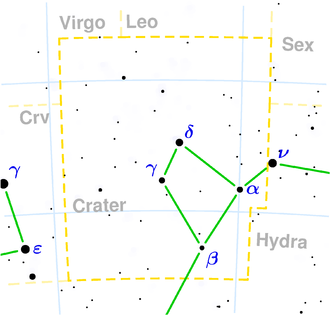IC 2623
| Galaxy IC 2623 |
|
|---|---|

|
|
| AladinLite | |
| Constellation | cups |
|
Position equinox : J2000.0 , epoch : J2000.0 |
|
| Right ascension | 11 h 03 m 50.9 s |
| declination | -20 ° 05 ′ 35 ″ |
| Appearance | |
| Morphological type | E. |
| Brightness (visual) | 13.5 likes |
| Brightness (B-band) | 14.5 mag |
| Angular expansion | 0.8 ′ × 0.5 ′ |
| Position angle | 70 ° |
| Surface brightness | 12.5 mag / arcmin² |
| Physical data | |
| Affiliation | isolated |
| Redshift | 0.012682 ± 0.000123 |
| Radial velocity | 3802 ± 37 km / s |
|
Stroke distance v rad / H 0 |
(162 ± 11) · 10 6 ly (49.6 ± 3.5) Mpc |
| history | |
| discovery | Herbert A. Howe |
| Discovery date | April 19, 1900 |
| Catalog names | |
| IC 2623 • PGC 33418 • ESO 569-033 • MCG -03-28-034 • 2MASX J11035096-2005347 • GALEX ASC J110350.93-200533.2 • LDCE 729 NED205 • 2MIG 1537 | |
IC 2623 is an elliptical galaxy of the Hubble-type E4 in the constellation Becher in the southern sky . It is estimated to be 162 million light years from the Milky Way and about 40,000 light years in diameter.
The object was discovered on April 19, 1900 by Herbert Alonzo Howe .
